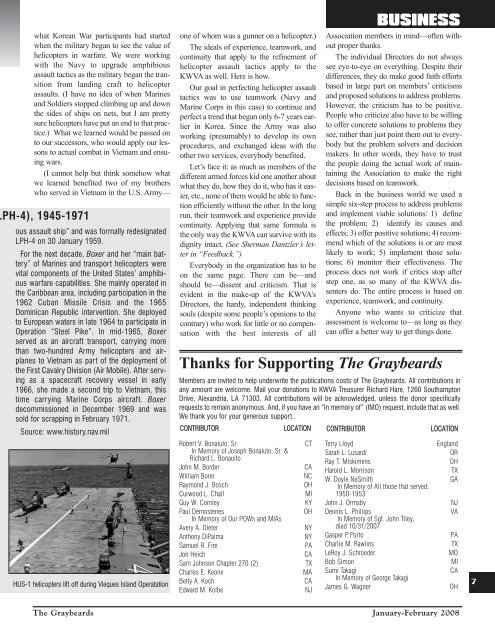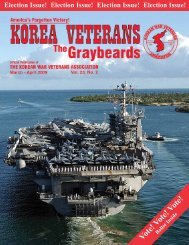Jan/Feb 2008 - KWVA - Korean War Veterans Association
Jan/Feb 2008 - KWVA - Korean War Veterans Association
Jan/Feb 2008 - KWVA - Korean War Veterans Association
You also want an ePaper? Increase the reach of your titles
YUMPU automatically turns print PDFs into web optimized ePapers that Google loves.
what <strong>Korean</strong> <strong>War</strong> participants had started<br />
when the military began to see the value of<br />
helicopters in warfare. We were working<br />
with the Navy to upgrade amphibious<br />
assault tactics as the military began the transition<br />
from landing craft to helicopter<br />
assaults. (I have no idea of when Marines<br />
and Soldiers stopped climbing up and down<br />
the sides of ships on nets, but I am pretty<br />
sure helicopters have put an end to that practice.)<br />
What we learned would be passed on<br />
to our successors, who would apply our lessons<br />
to actual combat in Vietnam and ensuing<br />
wars.<br />
(I cannot help but think somehow what<br />
we learned benefited two of my brothers<br />
who served in Vietnam in the U.S. Army—<br />
PH-4), 1945-1971<br />
ous assault ship” and was formally redesignated<br />
LPH-4 on 30 <strong>Jan</strong>uary 1959.<br />
For the next decade, Boxer and her “main battery”<br />
of Marines and transport helicopters were<br />
vital components of the United States’ amphibious<br />
warfare capabilities. She mainly operated in<br />
the Caribbean area, including participation in the<br />
1962 Cuban Missile Crisis and the 1965<br />
Dominican Republic intervention. She deployed<br />
to European waters in late 1964 to participate in<br />
Operation “Steel Pike”. In mid-1965, Boxer<br />
served as an aircraft transport, carrying more<br />
than two-hundred Army helicopters and airplanes<br />
to Vietnam as part of the deployment of<br />
the First Cavalry Division (Air Mobile). After serving<br />
as a spacecraft recovery vessel in early<br />
1966, she made a second trip to Vietnam, this<br />
time carrying Marine Corps aircraft. Boxer<br />
decommissioned in December 1969 and was<br />
sold for scrapping in <strong>Feb</strong>ruary 1971.<br />
Source: www.history.nav.mil<br />
HUS-1 helicopters lift off during Vieques Island Operatation<br />
one of whom was a gunner on a helicopter.)<br />
The ideals of experience, teamwork, and<br />
continuity that apply to the refinement of<br />
helicopter assault tactics apply to the<br />
<strong>KWVA</strong> as well. Here is how.<br />
Our goal in perfecting helicopter assault<br />
tactics was to use teamwork (Navy and<br />
Marine Corps in this case) to continue and<br />
perfect a trend that began only 6-7 years earlier<br />
in Korea. Since the Army was also<br />
working (presumably) to develop its own<br />
procedures, and exchanged ideas with the<br />
other two services, everybody benefited.<br />
Let’s face it: as much as members of the<br />
different armed forces kid one another about<br />
what they do, how they do it, who has it easier,<br />
etc., none of them would be able to function<br />
efficiently without the other. In the long<br />
run, their teamwork and experience provide<br />
continuity. Applying that same formula is<br />
the only way the <strong>KWVA</strong> can survive with its<br />
dignity intact. (See Sherman Dantzler’s letter<br />
in “Feedback.”)<br />
Everybody in the organization has to be<br />
on the same page. There can be—and<br />
should be—dissent and criticism. That is<br />
evident in the make-up of the <strong>KWVA</strong>’s<br />
Directors, the hardy, independent thinking<br />
souls (despite some people’s opinions to the<br />
contrary) who work for little or no compensation<br />
with the best interests of all<br />
BUSINESS<br />
<strong>Association</strong> members in mind—often without<br />
proper thanks.<br />
The individual Directors do not always<br />
see eye-to-eye on everything. Despite their<br />
differences, they do make good faith efforts<br />
based in large part on members’ criticisms<br />
and proposed solutions to address problems.<br />
However, the criticism has to be positive.<br />
People who criticize also have to be willing<br />
to offer concrete solutions to problems they<br />
see, rather than just point them out to everybody<br />
but the problem solvers and decision<br />
makers. In other words, they have to trust<br />
the people doing the actual work of maintaining<br />
the <strong>Association</strong> to make the right<br />
decisions based on teamwork.<br />
Back in the business world we used a<br />
simple six-step process to address problems<br />
and implement viable solutions: 1) define<br />
the problem; 2) identify its causes and<br />
effects; 3) offer positive solutions; 4) recommend<br />
which of the solutions is or are most<br />
likely to work; 5) implement those solutions;<br />
6) monitor their effectiveness. The<br />
process does not work if critics stop after<br />
step one, as so many of the <strong>KWVA</strong> dissenters<br />
do. The entire process is based on<br />
experience, teamwork, and continuity.<br />
Anyone who wants to criticize that<br />
assessment is welcome to—as long as they<br />
can offer a better way to get things done.<br />
Thanks for Supporting The Graybeards<br />
Members are invited to help underwrite the publications costs of The Graybeards. All contributions in<br />
any amount are welcome. Mail your donations to <strong>KWVA</strong> Treasurer Richard Hare, 1260 Southampton<br />
Drive, Alexandria, LA 71303. All contributions will be acknowledged, unless the donor specifically<br />
requests to remain anonymous. And, if you have an “In memory of” (IMO) request, include that as well.<br />
We thank you for your generous support..<br />
CONTRIBUTOR<br />
Robert V. Bonaiuto, Sr.<br />
In Memory of Joseph Bonaiuto, Sr. &<br />
Richard L. Bonauito<br />
John M. Border<br />
William Borer<br />
Raymond J. Bosch<br />
Curwood L. Chall<br />
Guy W. Comley<br />
Paul Demostenes<br />
` In Memory of Our POWs and MIAs<br />
Avery A. Dieter<br />
Anthony DiPalma<br />
Samuel R. Fire<br />
Jon Heich<br />
Sam Johnson Chapter 270 (2)<br />
Charles E. Keone<br />
Betty A. Koch<br />
Edward M. Kolbe<br />
LOCATION<br />
CT<br />
CA<br />
NC<br />
OH<br />
MI<br />
KY<br />
OH<br />
NY<br />
NY<br />
PA<br />
CA<br />
TX<br />
MA<br />
CA<br />
NJ<br />
CONTRIBUTOR<br />
LOCATION<br />
Terry Lloyd<br />
England<br />
Sarah L. Lusardi<br />
OR<br />
Ray T. Miskimens<br />
OH<br />
Harold L. Morrison<br />
TX<br />
W. Doyle NeSmith GA<br />
In Memory of All those that served,<br />
1950-1953<br />
John J. Ormsby<br />
NJ<br />
Dennis L. Phillips<br />
VA<br />
In Memory of Sgt. John Tiley,<br />
died 10/31/2007<br />
Gasper P. Porto<br />
PA<br />
Charlie M. Rawlins<br />
TX<br />
LeRoy J. Schroeder<br />
MO<br />
Bob Simon<br />
MI<br />
Sumi Takagi<br />
CA<br />
In Memory of George Takagi<br />
James G. Wagner<br />
OH<br />
7<br />
The Graybeards <strong>Jan</strong>uary-<strong>Feb</strong>ruary <strong>2008</strong>
















